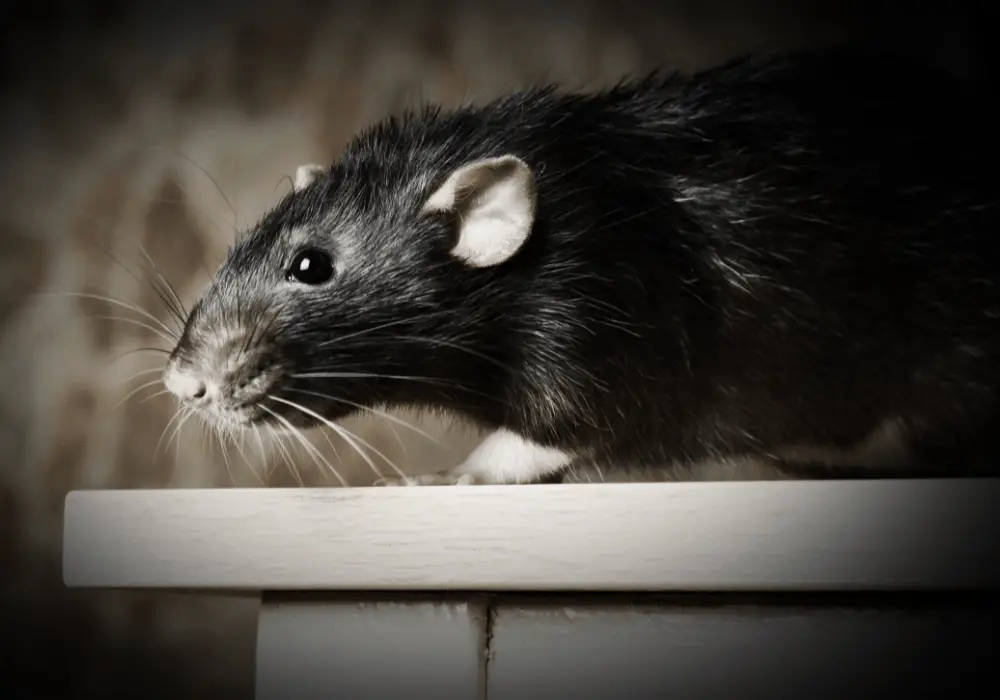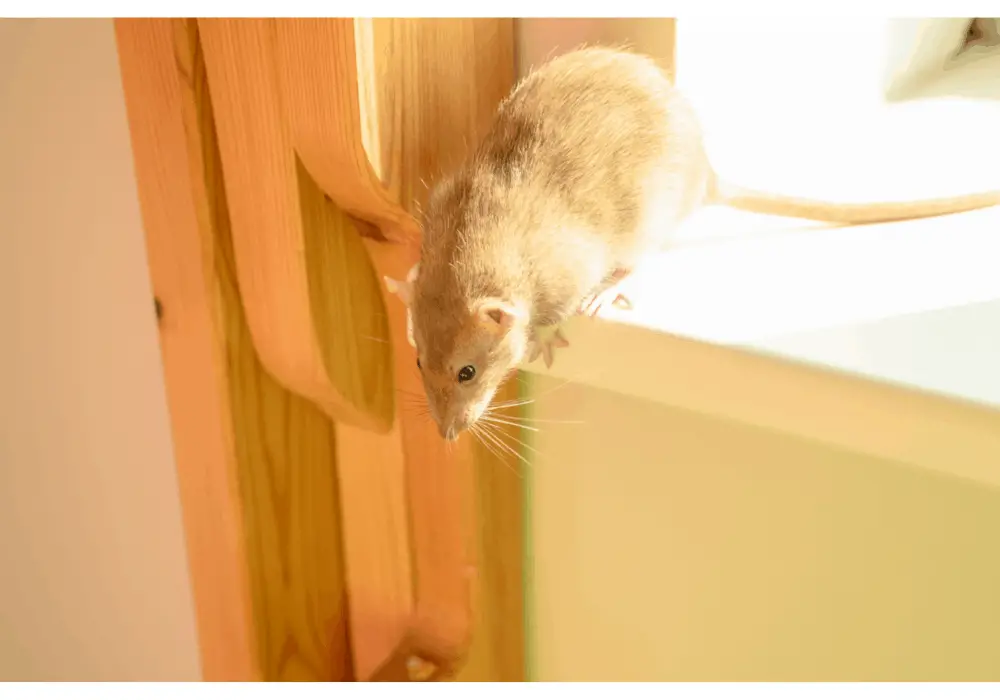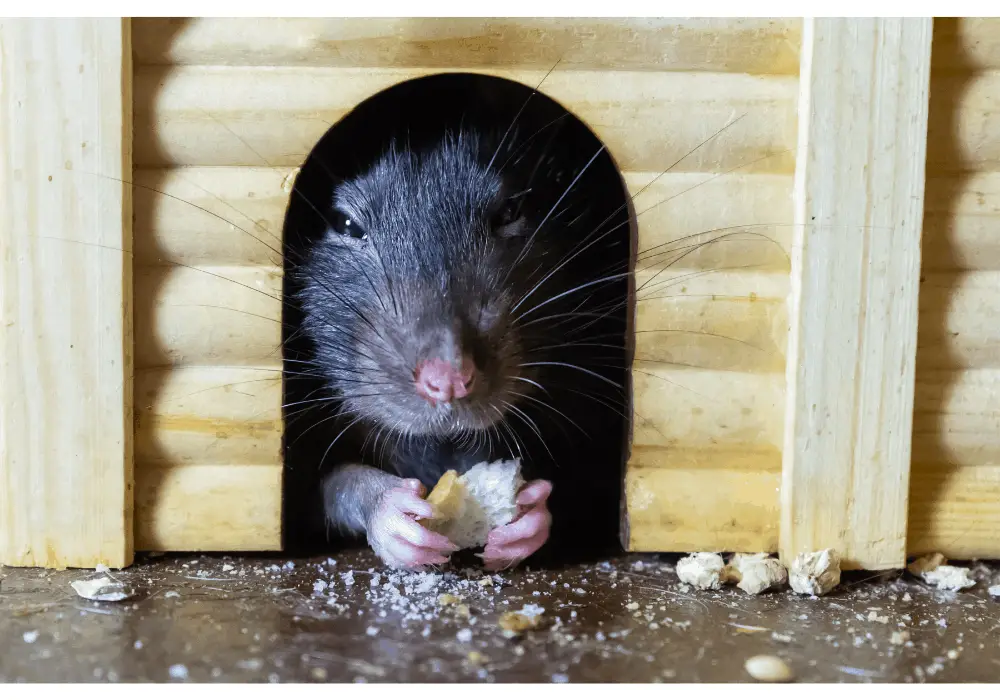It is a commonly known fact that rats are nocturnal and prefer to be active during the dark hours of the day, but can they get by without ever seeing sunlight? What about being kept in the dark entirely? How much light do they need? Let’s have a look at what research has to say about the effect of light on the health of rats.
Rats do not need exposure to direct sunlight. In fact, direct sunlight is harmful to their health and can cause hyperthermia, retinal damage, and cancer. Research has found that rats do best with at least 8 out of 24 hours of dim light at a minimum. Prolonged exposure to bright light can shorten lifespan (Azar et al., 2008).
The RSPCA recommends that all pet rats have access to a shelter or nesting box to protect them against direct sunlight. They should also be protected from extreme temperatures. It will be rather unlikely that you will ever come across a rat that loves to sunbathe the way cats and dogs do.

Why Should Rats Avoid Sunlight?
1. Rats are Sensitive to Overheating
Rats are not that gifted in the thermoregulatory department meaning that they have a hard time cooling themselves down when exposed to heat or warming up when exposed to cold. They do not sweat like humans or pant as dogs do. A rat’s main thermoregulatory reflex in order to cool down is by dilating the vessels in the tail. This helps body heat to escape by increasing the flow of blood to vessels close to the skin surface without insulating layers of fur or fat.
Unfortunately for rats, this method has limited thermoregulatory effect and the ideal temperature to keep rat at are 60 – 80 degrees Fahrenheit (around 15 – 25 degrees Celcius).
2. Rats’ Eyes are Extremely Sensitive to Bright Light
Rats can not see very well (they have excellent hearing and smell to make up for this fact). Their retinas (the area at the back of the eyeball where wavelengths are captured and then converted into an image) are prone to damage caused by exposure to bright light.
UV light from direct sunlight has been shown to be particularly harmful to a rat’s eyes. Albino rats with red or pink eyes are exceptionally sensitive to retinal damage due to bright light compared to rats from non-albino lines.
3. Increase Risk of Cancer
Prolonged exposure to UVA and UVB rays in sunlight causes malignant changes in skin cells. To begin with, rats as a species are very susceptible to cancer. Exposing them to unnecessary sunlight significantly increases their risk to developing cancer far above the normal risk rate (Beard et al., 1936). This includes multiple types of cancer such as mammary tumors (very common in rats) to skin cancer (more common in albino rats).
Will Rats Develop Rickets or Become Vitamin D Deficient if Not Exposed to Sunlight?
You may know that sunlight plays an important role in bone health. Sunlight, in simple terms, activates vitamin D in our bodies. Vitamin D helps to keep bones strong and healthy, especially in juveniles that are still growing. So, the question is: does this apply to rats as well?
A study done to evaluate whether experimentally induced rickets in rats can be reversed by exposure to sunlight (yes the ethics of this study is questionable! – It was done in 1921 by Hess et. al.) showed that a diet with sufficient calcium and potassium could reverse rickets in rats. Similar results were seen in the group of rats who were exposed to sunlight.
The control group, however, showed that a diet with sufficient calcium, potassium, and vitamin D, moderate phosphorus, and adequate protein, prevented the development of rickets.
The risks of sun exposure in rats far outweigh the minute benefit it has on vitamin D production. As long as your rats have access to a varied and balanced rat diet, there is no need for them to have potentially harmful UV exposure.

How Much Indoor Light do Rats Need?
The general guideline is that pet rats should always be kept indoors and have a maximum of 12 hours of light per day. They should have access to nesting boxes or hideouts where they can avoid light if they feel the need to.
What is the Effect of Too much Indoor Light on Rats?
A study by Vanogradova et al. (2019) evaluated the effect of having rats exposed to 24/7 light or to a 12/12 light-dark cycle. The study found that rats that were exposed to light 24/7 had a significant increase in the following health conditions:
- Diabetes: abnormal blood glucose levels where evident in 1 in 5 rats at 16 months in the 24/7 light group.
- Irregular estrus in females: By the end of the 17 month mark, 80% of the females in the 24/7 light group had irregular estrus cycles.
- Mammary Tumours: there were a significant increase in the incidence of mammary tumours in female rats in the 24/7 light group.
- Shortened life span: The rats in the 24/7 light group had a significantly shorter lifespan compared to the natural light group that had a 12/12 light/dark cycle.
How Do I know If The Light is Too Bright for My Rats?
Exposure to bright light has been shown to increase defecation and decrease social interaction under experimental conditions (Castelhano-Carlos and Baumans, 2009). Both of these are indications of stress. You can read more about stress in rats in my article on methods to calm a stressed rat.
Another study (Azar et al., 2008) found that housing rats in dim light and in a light cycle of 8 hours light, 16 hours dark significantly reduced average heart rates of the rats. The longer dark, shorter light cycle also increased their resilience to stressful conditions.
They showed fewer signs of stress or recovered to a relaxed state sooner after experimental stress-inducing procedures such as handling by an unknown handler or separation from cage mates. This translates into a reduced incidence of common disease and increased life span.
In the experiment mentioned above, a light brightness of 200 lux was used in the bright light group. I don’t know about you but I don’t happen to have a photometer lying around my house and I probably do not plan on getting one anytime soon.
It is safe to assume that dim light is best for your rats. So, enough for you to easily find your way around the room and interact with your rats, but not surgical theatre light. Basically, slightly brighter than romantic dinner date light.

Conclusion
Your rats will be most content away from direct sunlight and exposed to 12 hours or less light per day. They still love to be around you so no need to go hide your rats in the basement to protect them from bright light. As long as they have access to a large enough light-protected nesting box during times of bright light, they will be perfectly happy.
Keep in mind that they love interacting with their humans so having them in the living room where the family may spend most of their evenings is actually the ideal spot for rats in your home. As long as they have a healthy, varied diet, they do not need direct sunlight for bone health or vitamin D ‘activation’.
The downside of keeping your rats in a brightly lit area with direct sunlight is far greater than the enormous benefit your rats will get in the long run from being protected from high lumens of light or prolonged exposure to light.
There is no need to split hairs about the number of hours or the brightness of light your pet rats are exposed to. The goal of this article is simply to show that rats do not need sunlight and are better off in the long run with less light. They are nocturnal little critters after all!
References
- Abulmeaty, M., 2017. Sunlight exposure vs. vitamin D supplementation on bone homeostasis of vitamin D deficient rats. Clinical Nutrition Experimental, 11, pp.1-9. https://www.sciencedirect.com/science/article/pii/S2352939316300379
- Azar, T. A., Sharp, J. L., & Lawson, D. M. 2008. Effect of housing rats in dim light or long nights on heart rate. Journal of the American Association for Laboratory Animal Science : JAALAS, 47(4), 25–34. https://www.ncbi.nlm.nih.gov/pmc/articles/PMC2694710/
- Beard, H., Boggess, T. and Von Haam, E., 1936. Experimental Production of Malignant Tumors in the Albino Rat by Means of Ultraviolet Rays. The American Journal of Cancer, 27(2), pp.257-266. https://cancerres.aacrjournals.org/content/27/2/257.abstract
- Castelhano-Carlos, M. and Baumans, V., 2009. The impact of light, noise, cage cleaning and in-house transport on welfare and stress of laboratory rats. Laboratory Animals, 43(4), pp.311-327. https://journals.sagepub.com/doi/full/10.1258/la.2009.0080098
- Hess, A., Unger, L. and Pappenheimer, A., 1921. III. Experimental rickets The prevention of rickets in rats by exposure to sunlight.1. Experimental Biology and Medicine, 19(1), pp.8-12. https://www.jbc.org/article/S0021-9258(18)85952-X/pdf
- OKANO, T., YASUMURA, M., MIZUNO, K. and KOBAYASHI, T., 1977. Photochemical conversion of 7-dehydrocholesterol into vitamin D3 in rat skins. Journal of Nutritional Science and Vitaminology, 23(2), pp.165-168. https://www.jstage.jst.go.jp/article/jnsv1973/23/2/23_2_165/_article/-char/ja/
- Vinogradova, I., Anisimov, V., Bukalev, A., Semenchenko, A. and Zabezhinski, M., 2009. Circadian disruption induced by light-at-night accelerates aging and promotes tumorigenesis in rats. Aging, 1(10), pp.855-865. https://www.ncbi.nlm.nih.gov/pmc/articles/PMC2816394/
